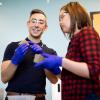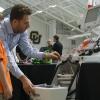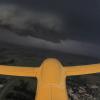Research
 Wil Srubar is an assistant professor of civil, environmental and architectural engineering department at CU. Guided by the tenets of industrial ecology, his team's collective vision is to engineer next-generation infrastructure materials by blurring the boundaries between the built environment and the natural world. Materials of current interest include biodegradable polymers, phase-change materials, recycled aggregate concrete, and natural-fiber composites for green building applications.
Wil Srubar is an assistant professor of civil, environmental and architectural engineering department at CU. Guided by the tenets of industrial ecology, his team's collective vision is to engineer next-generation infrastructure materials by blurring the boundaries between the built environment and the natural world. Materials of current interest include biodegradable polymers, phase-change materials, recycled aggregate concrete, and natural-fiber composites for green building applications. Research being led by CU Boulder Assistant Professor Orit Peleg is studying social systems in sunflowers through an award from the Human Frontier Science Program.
Research being led by CU Boulder Assistant Professor Orit Peleg is studying social systems in sunflowers through an award from the Human Frontier Science Program. Research at CU Boulder are trying to understanding how construction plans are read on job sites and then tailoring the information to the individual. Increasing efficiency, reducing costs and – potentially – reducing the risk of an accident.
Research at CU Boulder are trying to understanding how construction plans are read on job sites and then tailoring the information to the individual. Increasing efficiency, reducing costs and – potentially – reducing the risk of an accident. The Materials Characterization Facility in the Colorado Shared Instrumentation in Nanofabrication and Characterization (COSINC) successfully hosted a focused ion beam (FIB) event in mid-April.
The Materials Characterization Facility in the Colorado Shared Instrumentation in Nanofabrication and Characterization (COSINC) successfully hosted a focused ion beam (FIB) event in mid-April. CU Boulder has a tradition of excellence in quantum science and technology. Work in the field continues on and off campus in the many companies that have been founded by CU engineering and physics faculty and former students.
CU Boulder has a tradition of excellence in quantum science and technology. Work in the field continues on and off campus in the many companies that have been founded by CU engineering and physics faculty and former students. Want more accurate weather forecasts? You’re in luck: Last month, researchers at CU Boulder saw the fruits of their labors launch aboard a new satellite. That satellite is the first in a planned fleet of Earth-orbiters that the team says will one day record weather data at every point on the globe every 15 minutes.
Want more accurate weather forecasts? You’re in luck: Last month, researchers at CU Boulder saw the fruits of their labors launch aboard a new satellite. That satellite is the first in a planned fleet of Earth-orbiters that the team says will one day record weather data at every point on the globe every 15 minutes. The College of Engineering and Applied Science at CU Boulder is part of a new NASA funded Space Technology Research Institute that will advance space habitat designs using resilient and autonomous systems. The work is part of a larger effort to prepare for a time when astronauts will venture further into space, out of low-Earth orbit and on to the Moon, Mars and beyond.
The College of Engineering and Applied Science at CU Boulder is part of a new NASA funded Space Technology Research Institute that will advance space habitat designs using resilient and autonomous systems. The work is part of a larger effort to prepare for a time when astronauts will venture further into space, out of low-Earth orbit and on to the Moon, Mars and beyond. More than 140 student teams from six College of Engineering and Applied Science units ringed the Indoor Practice Field to show off their capstone and graduate projects, which Dean Bobby Braun hailed as “truly innovative.”
More than 140 student teams from six College of Engineering and Applied Science units ringed the Indoor Practice Field to show off their capstone and graduate projects, which Dean Bobby Braun hailed as “truly innovative.” Researchers from CU Boulder will fly drones into severe storms this spring and in 2020 in one of the largest and most ambitious drone-based investigations of meteorological phenomena ever.
Researchers from CU Boulder will fly drones into severe storms this spring and in 2020 in one of the largest and most ambitious drone-based investigations of meteorological phenomena ever.
 Twenty-five YOU’RE@CU Undergraduate Research Students will present their work in a poster session from 5-6 p.m. on April 29 in the Engineering Center lobby.
Twenty-five YOU’RE@CU Undergraduate Research Students will present their work in a poster session from 5-6 p.m. on April 29 in the Engineering Center lobby.

